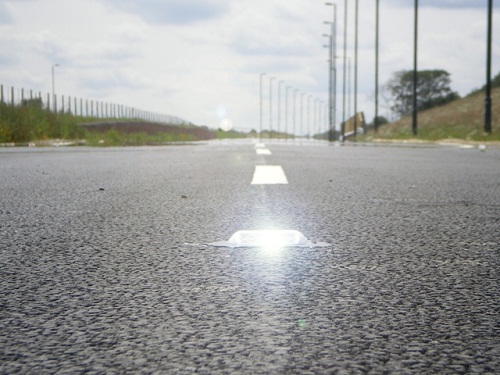Road studs are mechanical markers used to complement painted road markings. The purpose of these materials is to enhance reflectivity and visibility of road lines in hazard-prone areas, particularly during the night. These studs come in different forms and reflective capacity; their usage depends on the type of environment and road surface.
The following are the common types of mechanical markers used on highways to improve traffic conditions and reduce road accidents:
Cat’s eyes – These are safety devices that consist of four reflective lenses, two facing one direction and two facing the other direction. The lenses are encased in a rubberized dome and housed in a cast-iron mount that protects the device from being damaged when driven over. The lenses, when hit by car lights, reflect the light back so drivers can see them like a pair of glowing cat’s eyes. They are mainly used in the center of roads as lane dividers and in road margins.
The cat’s eye is the first of the mechanical markers to be invented and used. It was invented in Halifax, West Yorkshire, England by Percy Shaw, who conceived the idea in 1934 and successfully patented the first cat’s eye products in 1935. His inspiration was the reflective shine from the cat’s eyes when hit by light.
Botts’ dots – These are non-reflective road markers that appear only as raised white dots along the road pavement. Bott’s dots are used with reflective devices to mark lane boundaries and road margins. Instead of alerting drivers through visual reflective signals, they provide tactile signals that tell drivers they are driving along lane boundaries when the dots are driven over.
The Botts’ dots were named after Dr. Elbert Botts, the engineer who oversaw the research of the dots’ development in 1953. Dr. Botts was a California Department of Transportation engineer that time and first suggested dots that are made of glass.
Rumble strips – These markers serve the same purpose as the Botts’ dots. They are non-reflective and they provide tactile signals when driven over to alert drivers. These markers are used in different ways—as shoulder rumble strips, centerline rumble strips, and transverse rumble strips. They also come in different types: rolled-in (applied on newly laid asphalt), milled-in (applied on existing asphalt pavement), formed (pressed into fresh concrete), raised plastic (fastened to asphalt or concrete), profiled thermoplastic (thermoplastic fused to the pavement), and “smart car” (virtual rumble strips).
The use of rumble strips was first implemented in New Jersey in 1952. The strips were used as shoulder rumble strips in freeways using the rolled-in types.
Reflective markers – These markers use reflective properties similar to the popular road studs and usually serve as travel lane dividers. These markers alert drivers on whether they are driving in the right direction or lane, or they are driving in the wrong direction or lane. They work by reflecting white light back to drivers to indicate that they are driving in the right direction or lane, and by reflecting red light back to those who are driving in the opposite direction or traffic lane.
Today, the most-widely used reflective road stud is the Stimsonite road stud by Sidney Heenan of Amerace Corporation. These work like the cat’s eyes, but offered easier installation and are also cheaper to produce. Stimsonite road studs are widely available through trusted road markings suppliers and are now used in every part of the United States.

